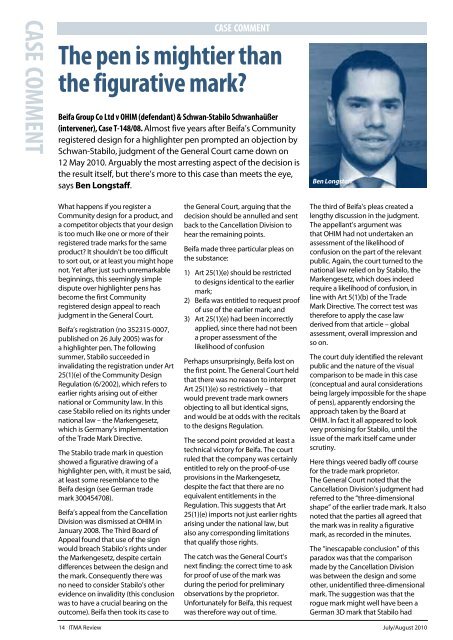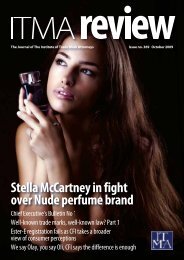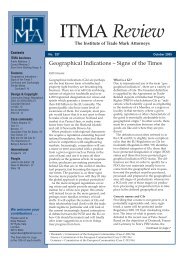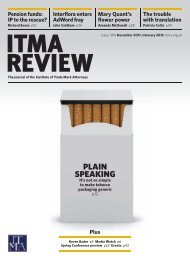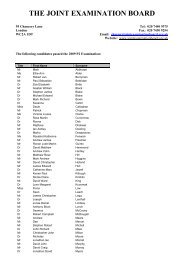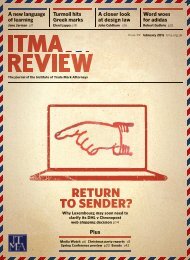case comment - ITMA
case comment - ITMA
case comment - ITMA
Create successful ePaper yourself
Turn your PDF publications into a flip-book with our unique Google optimized e-Paper software.
CASE COMMENT<br />
CASE COMMENT<br />
The pen is mightier than<br />
the figurative mark?<br />
Beifa Group Co Ltd v OHIM (defendant) & Schwan-Stabilo Schwanhaüßer<br />
(intervener), Case T-148/08. Almost five years after Beifa’s Community<br />
registered design for a highlighter pen prompted an objection by<br />
Schwan-Stabilo, judgment of the General Court came down on<br />
12 May 2010. Arguably the most arresting aspect of the decision is<br />
the result itself, but there’s more to this <strong>case</strong> than meets the eye,<br />
says Ben Longstaff.<br />
What happens if you register a<br />
Community design for a product, and<br />
a competitor objects that your design<br />
is too much like one or more of their<br />
registered trade marks for the same<br />
product? It shouldn’t be too difficult<br />
to sort out, or at least you might hope<br />
not. Yet after just such unremarkable<br />
beginnings, this seemingly simple<br />
dispute over highlighter pens has<br />
become the first Community<br />
registered design appeal to reach<br />
judgment in the General Court.<br />
Beifa’s registration (no 352315-0007,<br />
published on 26 July 2005) was for<br />
a highlighter pen. The following<br />
summer, Stabilo succeeded in<br />
invalidating the registration under Art<br />
25(1)(e) of the Community Design<br />
Regulation (6/2002), which refers to<br />
earlier rights arising out of either<br />
national or Community law. In this<br />
<strong>case</strong> Stabilo relied on its rights under<br />
national law – the Markengesetz,<br />
which is Germany’s implementation<br />
of the Trade Mark Directive.<br />
The Stabilo trade mark in question<br />
showed a figurative drawing of a<br />
highlighter pen, with, it must be said,<br />
at least some resemblance to the<br />
Beifa design (see German trade<br />
mark 300454708).<br />
Beifa’s appeal from the Cancellation<br />
Division was dismissed at OHIM in<br />
January 2008. The Third Board of<br />
Appeal found that use of the sign<br />
would breach Stabilo’s rights under<br />
the Markengesetz, despite certain<br />
differences between the design and<br />
the mark. Consequently there was<br />
no need to consider Stabilo’s other<br />
evidence on invalidity (this conclusion<br />
was to have a crucial bearing on the<br />
outcome). Beifa then took its <strong>case</strong> to<br />
14 <strong>ITMA</strong> Review<br />
the General Court, arguing that the<br />
decision should be annulled and sent<br />
back to the Cancellation Division to<br />
hear the remaining points.<br />
Beifa made three particular pleas on<br />
the substance:<br />
1) Art 25(1)(e) should be restricted<br />
to designs identical to the earlier<br />
mark;<br />
2) Beifa was entitled to request proof<br />
of use of the earlier mark; and<br />
3) Art 25(1)(e) had been incorrectly<br />
applied, since there had not been<br />
a proper assessment of the<br />
likelihood of confusion<br />
Perhaps unsurprisingly, Beifa lost on<br />
the first point. The General Court held<br />
that there was no reason to interpret<br />
Art 25(1)(e) so restrictively – that<br />
would prevent trade mark owners<br />
objecting to all but identical signs,<br />
and would be at odds with the recitals<br />
to the designs Regulation.<br />
The second point provided at least a<br />
technical victory for Beifa. The court<br />
ruled that the company was certainly<br />
entitled to rely on the proof-of-use<br />
provisions in the Markengesetz,<br />
despite the fact that there are no<br />
equivalent entitlements in the<br />
Regulation. This suggests that Art<br />
25(1)(e) imports not just earlier rights<br />
arising under the national law, but<br />
also any corresponding limitations<br />
that qualify those rights.<br />
The catch was the General Court’s<br />
next finding: the correct time to ask<br />
for proof of use of the mark was<br />
during the period for preliminary<br />
observations by the proprietor.<br />
Unfortunately for Beifa, this request<br />
was therefore way out of time.<br />
Ben Longstaff<br />
The third of Beifa’s pleas created a<br />
lengthy discussion in the judgment.<br />
The appellant’s argument was<br />
that OHIM had not undertaken an<br />
assessment of the likelihood of<br />
confusion on the part of the relevant<br />
public. Again, the court turned to the<br />
national law relied on by Stabilo, the<br />
Markengesetz, which does indeed<br />
require a likelihood of confusion, in<br />
line with Art 5(1)(b) of the Trade<br />
Mark Directive. The correct test was<br />
therefore to apply the <strong>case</strong> law<br />
derived from that article – global<br />
assessment, overall impression and<br />
so on.<br />
The court duly identified the relevant<br />
public and the nature of the visual<br />
comparison to be made in this <strong>case</strong><br />
(conceptual and aural considerations<br />
being largely impossible for the shape<br />
of pens), apparently endorsing the<br />
approach taken by the Board at<br />
OHIM. In fact it all appeared to look<br />
very promising for Stabilo, until the<br />
issue of the mark itself came under<br />
scrutiny.<br />
Here things veered badly off course<br />
for the trade mark proprietor.<br />
The General Court noted that the<br />
Cancellation Division’s judgment had<br />
referred to the “three-dimensional<br />
shape” of the earlier trade mark. It also<br />
noted that the parties all agreed that<br />
the mark was in reality a figurative<br />
mark, as recorded in the minutes.<br />
The “inescapable conclusion” of this<br />
paradox was that the comparison<br />
made by the Cancellation Division<br />
was between the design and some<br />
other, unidentified three-dimensional<br />
mark. The suggestion was that the<br />
rogue mark might well have been a<br />
German 3D mark that Stabilo had<br />
July/August 2010


